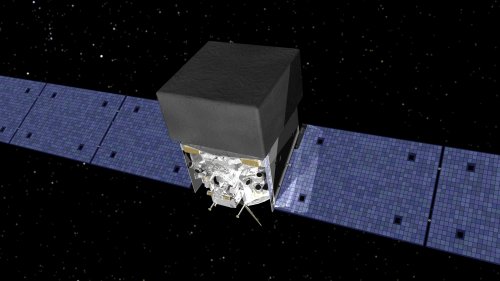
The GLAST gamma-ray telescope was launched into space at 12.05 p.m. local time from Cape Canaveral in Florida today. The instrument is due to orbit some 560 km above the Earth’s surface where it will begin its survey of gamma rays from throughout the universe. Physicists involved in the project hope that GLAST (the Gamma-ray Large Area Space Telescope) will help them study some of the most violent events in the universe, provide a new window into the early universe and even shed light on the origins of dark matter.
The four-tonne observatory is packed with state-of-the-art particle detectors including GLAST’s primary instrument — the Large Area Telescope (LAT), which will cover the energy band between 20 MeV and at least 300 GeV. A second instrument, the GLAST Burst Monitor (GBM), will detect transient sources such gamma-ray bursts and solar flares down to energies of just 8 keV.
It took a lot of people in many countries to make this 16-year journey come to fruition Peter Michelson, Stanford University
GLAST must operate in space because gamma rays cannot penetrate even a few kilometres through Earth’s upper atmosphere. It is, though, possible to do some gamma-ray astronomy with ground-based telescopes by measuring the particles the gamma rays produce when they strike the matter in the atmosphere. However, such telescopes can only detect gamma-rays with energies of less than 100 GeV.
Gamma-ray bursts
One objective of the mission is to gain a better understanding of the origins of gamma-ray bursts. These poorly-understood events occur at a rate of about one per day, and briefly shine as the brightest objects in the universe. GLAST could allow to scientists to measure the total energy released in such bursts and the nature of their high-energy spectra — both of which have never been done.
GLAST will also target extreme events that occur in active galaxies when matter is accelerated to relativistic energies in a jet powered by a supermassive black hole. This results in the emission of gamma rays with a power equivalent to that of all the stars in an entire galaxy over all wavelengths. Until now, gamma-ray detectors have not been able to measure these highly variable emissions in any detail over long timescales, but GLAST will allow physicists to see into these jets, thus revealing their contents and dynamics.
GLAST will also support research in several areas in fundamental physics. One such opportunity is provided by the diffuse gamma-ray cosmic background — a poorly-understood haze of giga-electron-volt gamma rays that theorists currently attribute to cascades from distant tera-electron-volt gamma-ray sources, ultrahigh-energy cosmic rays, and even Hawking radiation emitted by primordial black holes.
Another area concerns one of the most fundamental questions in cosmology: the origin and distribution of dark matter. An important class of theories predicts the existence of weakly interacting massive particles, or WIMPs. In most models, WIMPs may annihilate in pairs, thus producing high-energy particles, including gamma rays. GLAST could be capable of detecting this radiation from annihilation events in the galactic halo, providing unique information about dark matter.
$690m price tag
The mission cost $690m and is a collaboration between NASA, the US Department of Energy and universities and research institutes in the US, Japan, Italy, France and Sweden.
“It took a lot of people in many countries to make this 16-year journey come to fruition,” says Peter Michelson, a physicist at Stanford University and principal investigator for the LAT.
Over the next two months the GLAST’s instruments will be tuned and calibrated. “First light”, when the telescope takes its first image of the sky, should happen in about four weeks and GLAST should start gathering data by mid-August.
Update 12 June 2008
After a 75 minute flight, GLAST settled into orbit and both of its solar arrays were deployed successfully.



